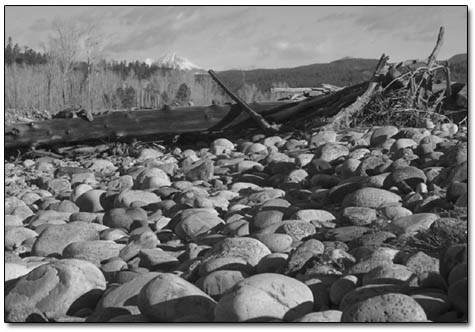 |
A tangle of driftwood lies
on a rocky beach along a dry portion of the Animas River
near Baker’s Bridge. With the San Juan snowpack slightly
better off than it was last year at this time, local water
officials are taking a closer look at measures to reduce
the effects of drought, including higher water rates, rebates
for low-water-usage appliances and mandatory
water restrictions./Photo by Todd Newcomer. |
With the San Juan snowpack
only slightly better than it was last year at this time, the
Durango Water Commission has started preparing for another possible
summer of drought.
“We’re cautiously looking at the next step, at
the worst-case scenario,” said Commissioner Kent Ford.
According to Ford, this scenario could take many forms, from
the drying-up of the Animas and Florida rivers – which
constitute the city water supply – to storm runoff from
the fire zones clouding that supply. While both are serious
considerations, Ford said it is the latter of the two that poses
the biggest threat.
“One big thunderstorm and the river turns to chocolate
and the city reservoir turns to chocolate, and it’s going
to be a problem,” he said.
Increased sediment in the water puts additional strain on the
city’s already over-taxed water treatment plant. If the
murkiness proves too much to treat, the plant must close its
intake pumps on the Animas, forcing the city to rely on water
from Terminal Reservoir, on the College Mesa. However, the 75
million-gallon reservoir only holds seven days’ worth
of water, which makes city water officials and residents alike
nervous.
However, with snowpack levels higher than those in 2002, some
feel secure that the Animas has seen its lowest point, and the
threat of the river running dry this summer is remote. Jack
Rogers, director of Durango Public Works, said during the peak
usage day last summer, the city drew 15 cfs from the Animas
River and 9 cfs from the Florida. In contrast, the Animas hit
a low flow of 116 cfs last summer, on Aug. 28. Nevertheless,
Rogers said he is not comfortable resting on these laurels.
“I’m sure no one who lives in the community can
ever remember the river going dry, but that doesn’t mean
it won’t happen,” he said.
As a result, the city is developing strategies now to deal
with water shortages. Rogers said this year’s plan will
differ from last year’s in that it will focus on education
as well as regulation.
“We didn’t do such a good job of informing the
public last year,” he said. “We sent mixed messages.”
Rogers said one message that was particularly damaging was
the “use it or lose it” mentality.
“I think some of the sentiment was that if we don’t
use it, it just goes to Las Vegas,” he said. “That’s
probably not the best message to be sending to the public.
“We wouldn’t want our neighbors upstream treating
us that way,” he continued. “And I don’t think
we should be treating others that way.”
Rogers said education will consist of water-conservation tips
that will be posted on the city’s website and will be
included in residents’ monthly water bills. He also said
the city will be releasing news releases regularly on water-conservation
measures.
“We want to let people know how they can conserve water,”
he said.
The city also may rely on voluntary water restrictions, where
residents are asked to limit outdoor watering, and will have
the added muscle of mandatory restrictions. Such restrictions,
a change to city ordinances, were approved by the City Council
last August. According to the new ordinance, the city manager
is able to pass mandatory restrictions at a moment’s notice
and fine violators. Penalties range from written warnings to
$300 fines.
Rogers said he was not sure what such mandatory restrictions
would entail, but he did say that given the city’s small
backup water supply, they likely would be rigid.
“We don’t have a lot of storage, so we’ll
have to take stringent measures,” he said. “It’s
probably going to be more severe than just limiting lawn watering.”
In addition to these measures, the city also is mulling over
further strategies, including incentives for residents and businesses
that install low-water fixtures and appliances and penalties
in the form of higher rates for excessive water users.
However, Rogers noted that implementing a three-tier rate structure
– the city currently uses a two-tiered one – could
be a thorny issue.
“The hard part is deciding what constitutes ‘excessive,’”
he said.
Furthermore, residents are two years into a six-year rate-hike
program that will help cover the cost of about $20 million in
water-system upgrades, and may not be amenable to bigger water
bills. At least one water commissioner expressed concern that
such an increase could make residents go to extremes of stopping
all outdoor watering to avoid costly water bills.
“I don’t want to do anything that makes Durango
look like Farmington,” said Fred Kroeger, during the commission’s
Monday meeting.
However, fellow Commissioner Chris Wilbur pointed out that
relative to other municipalities in Colorado, Durango water
is still a bargain.
“Water’s cheap,” he said. “It’s
still cheap in Durango.”
Despite the misgivings, water commissioners seemed generally
open to the idea of a three-tier rate structure as well as rebates
for low-water appliances, ordering city staffers to explore
the options further.
“Overall, I think we need to switch to more efficient
things,” said Commissioner Bob Wolff. “I think (a
third rate) is the easiest thing to do.”
And while commissioners and city officials say they are preparing
for the worst, they point out that, with a few months of winter
remaining and the city’s senior water rights on the river,
there is no reason to sound the alarms just yet.
“The city has a reasonable amount of water,” said
Ford. “On the bright side, we don’t have a reservoir
that’s empty, and the Animas runs unimpaired down to us.
“Until the Animas dries up, we’re really OK.”

